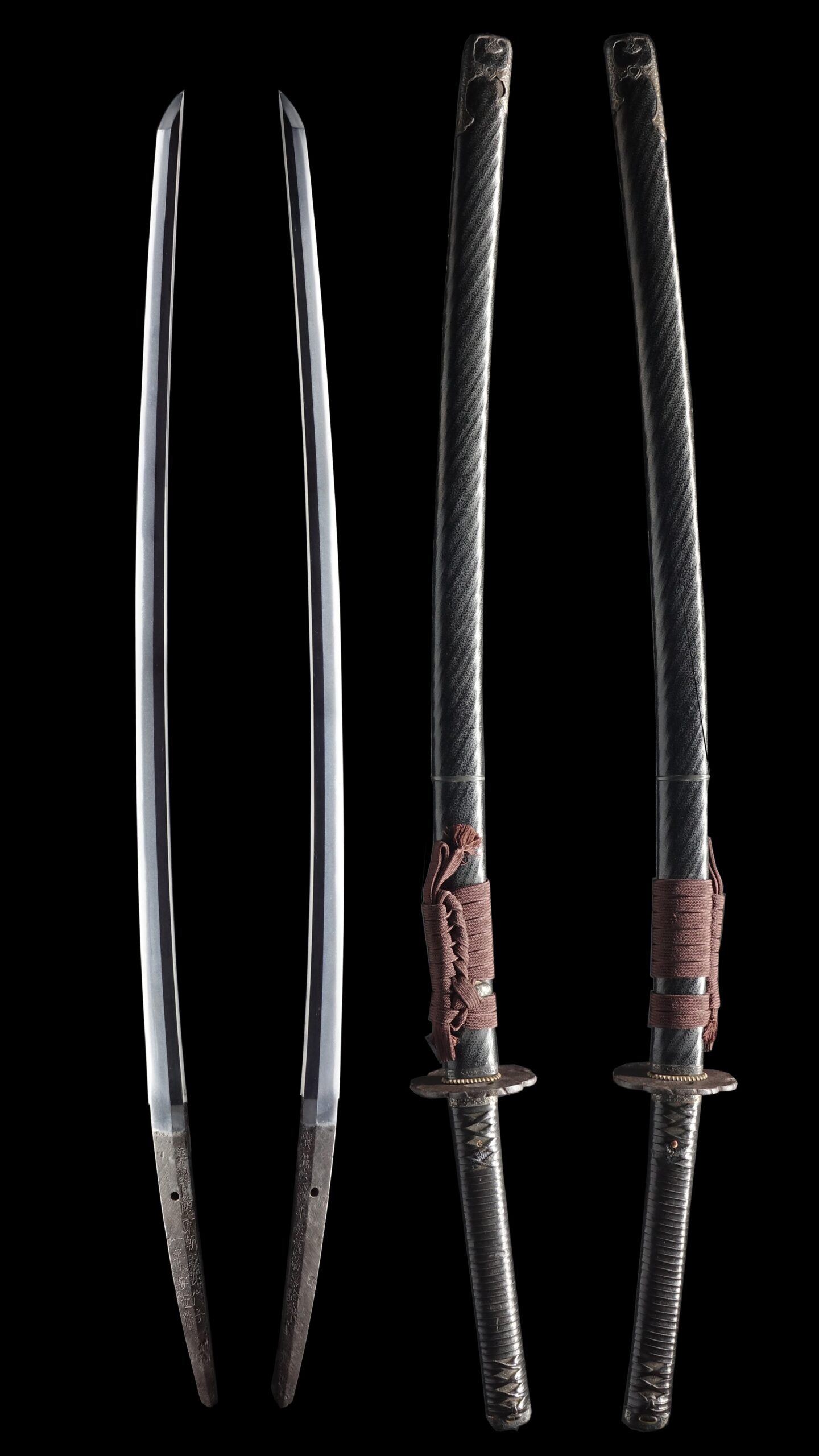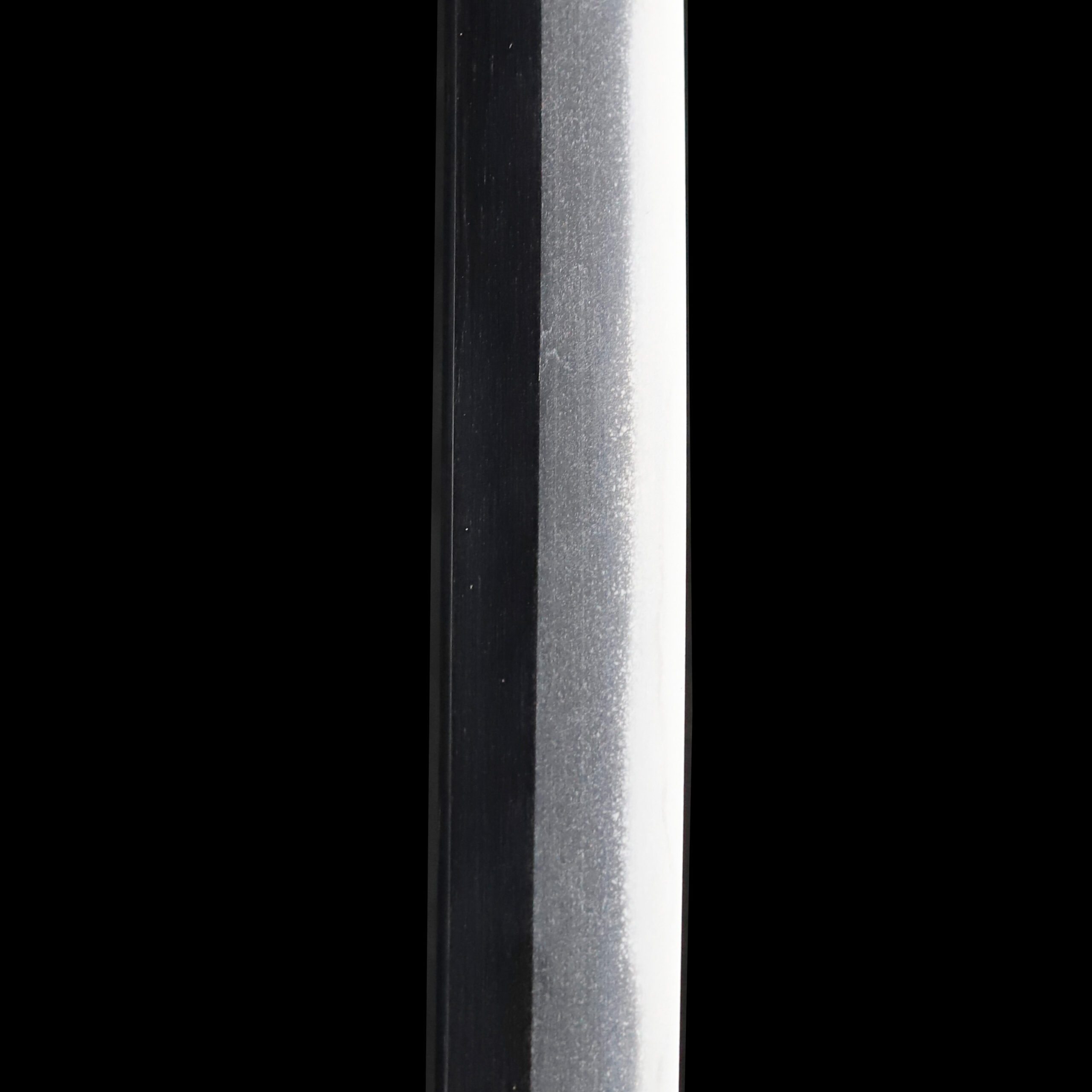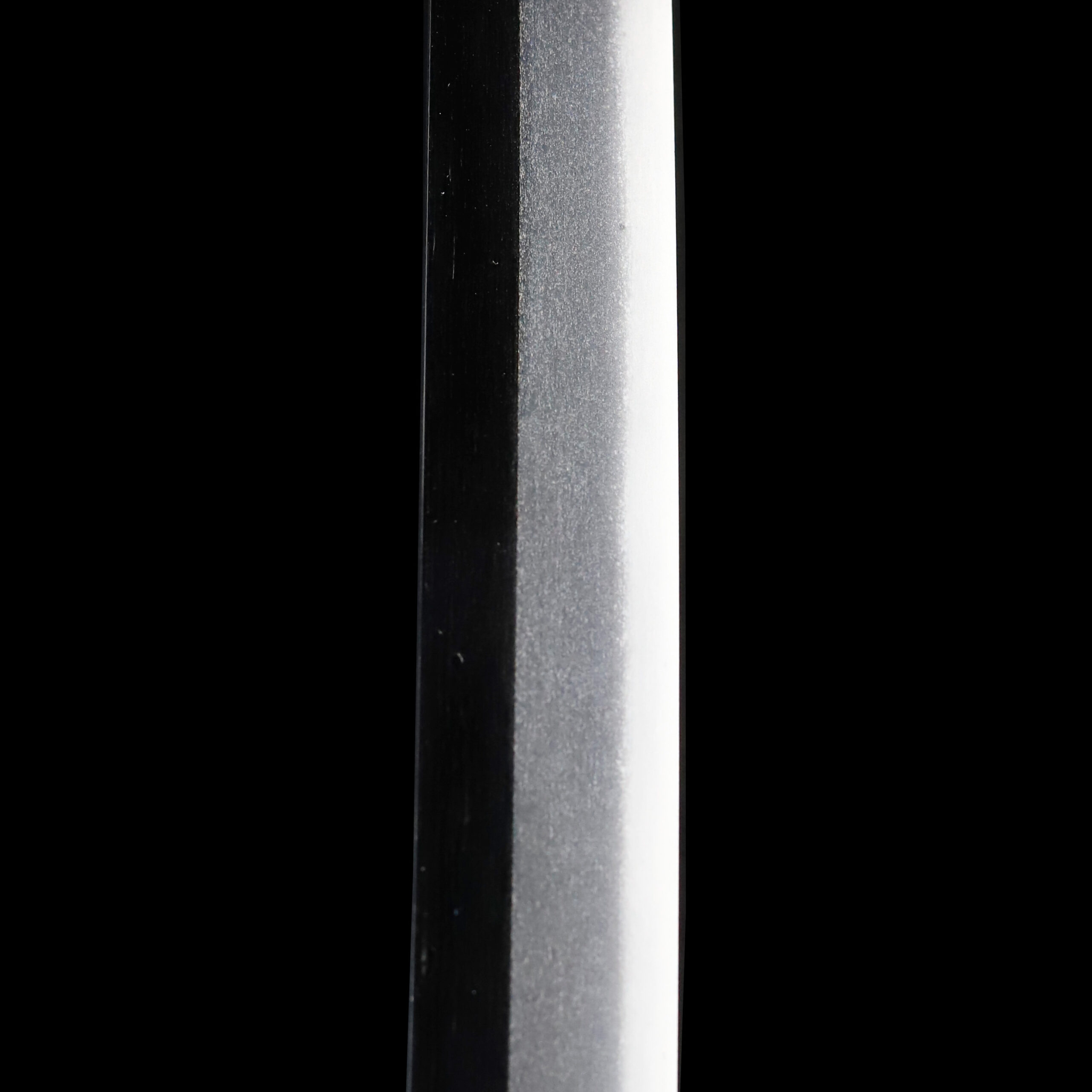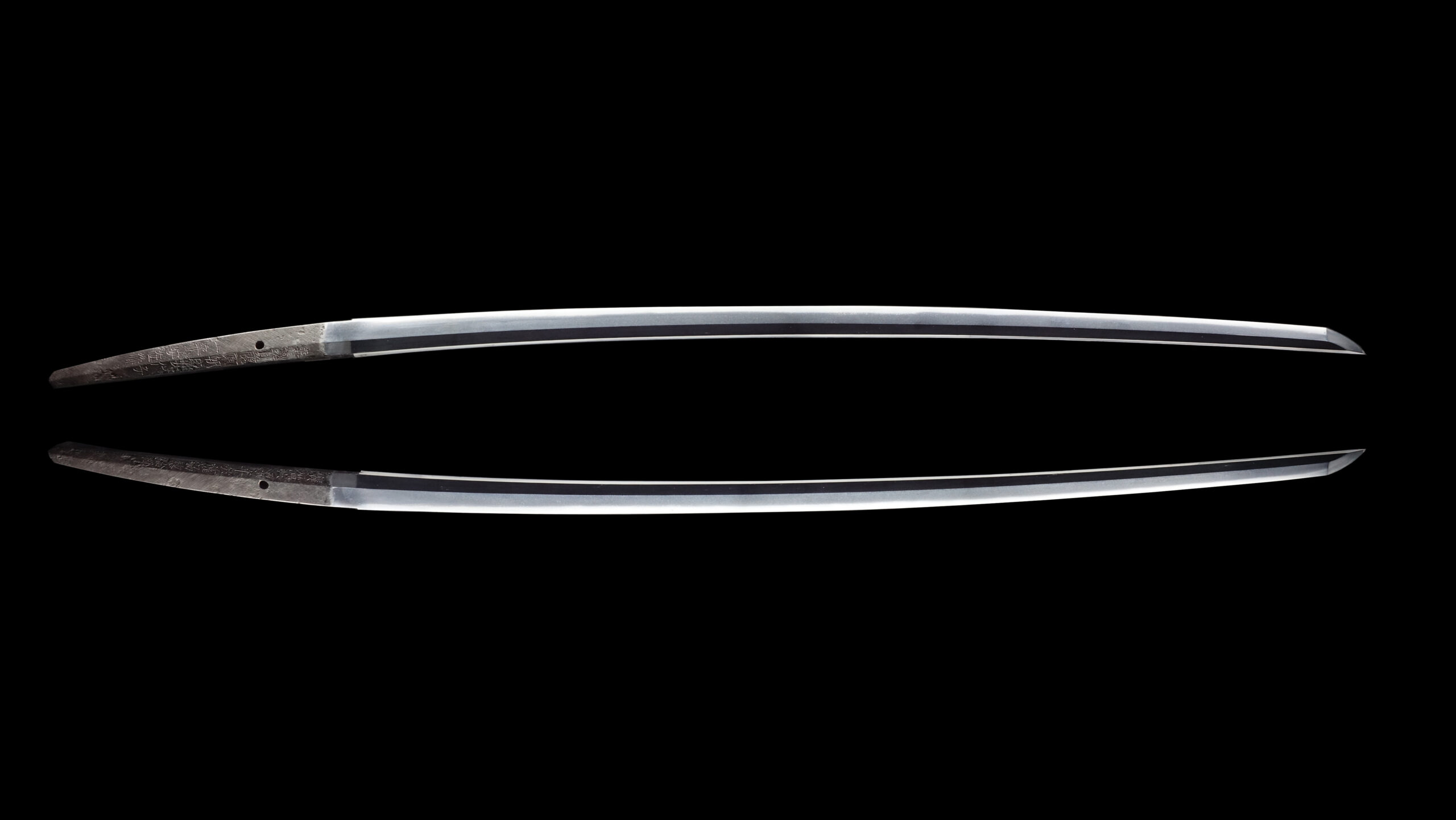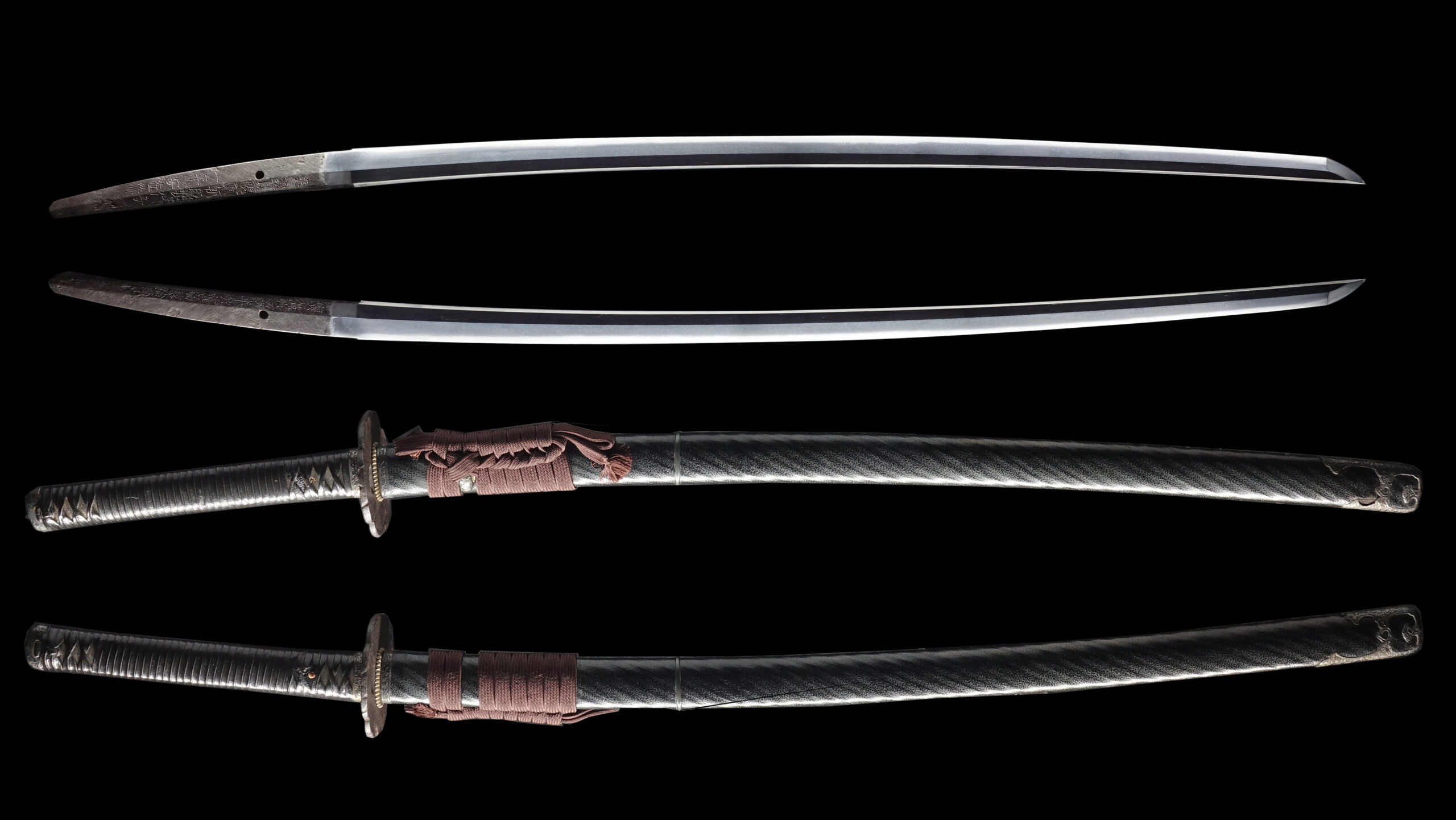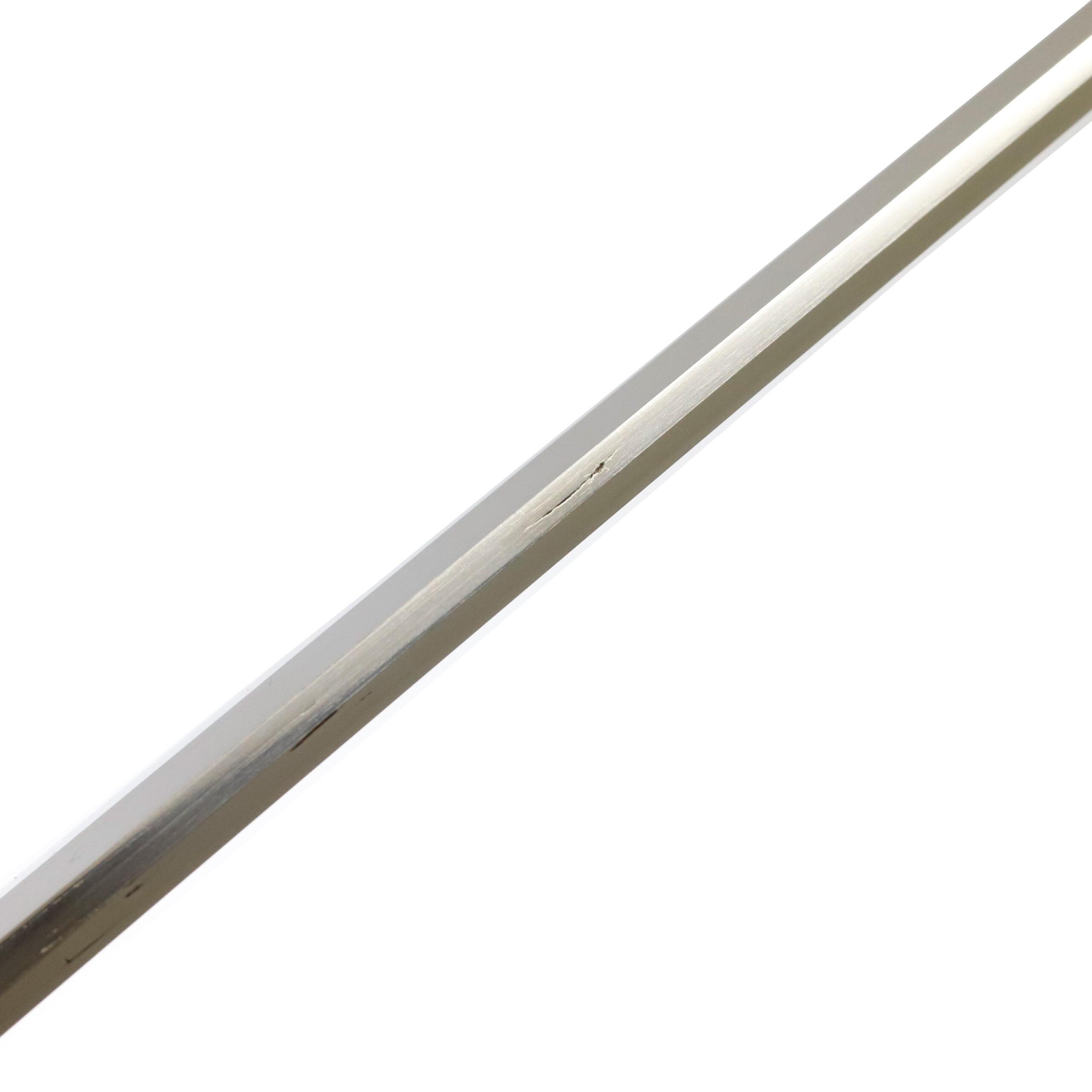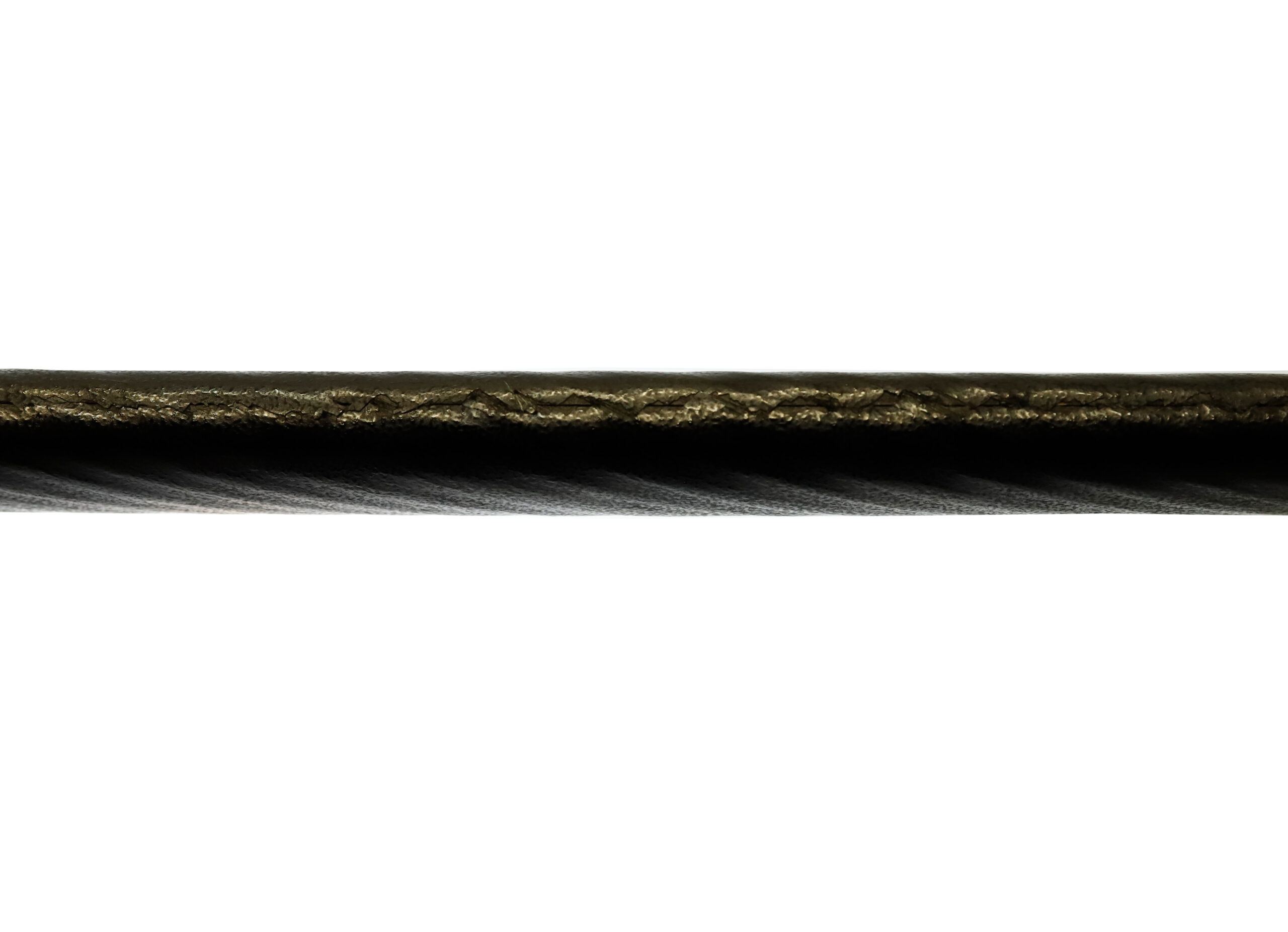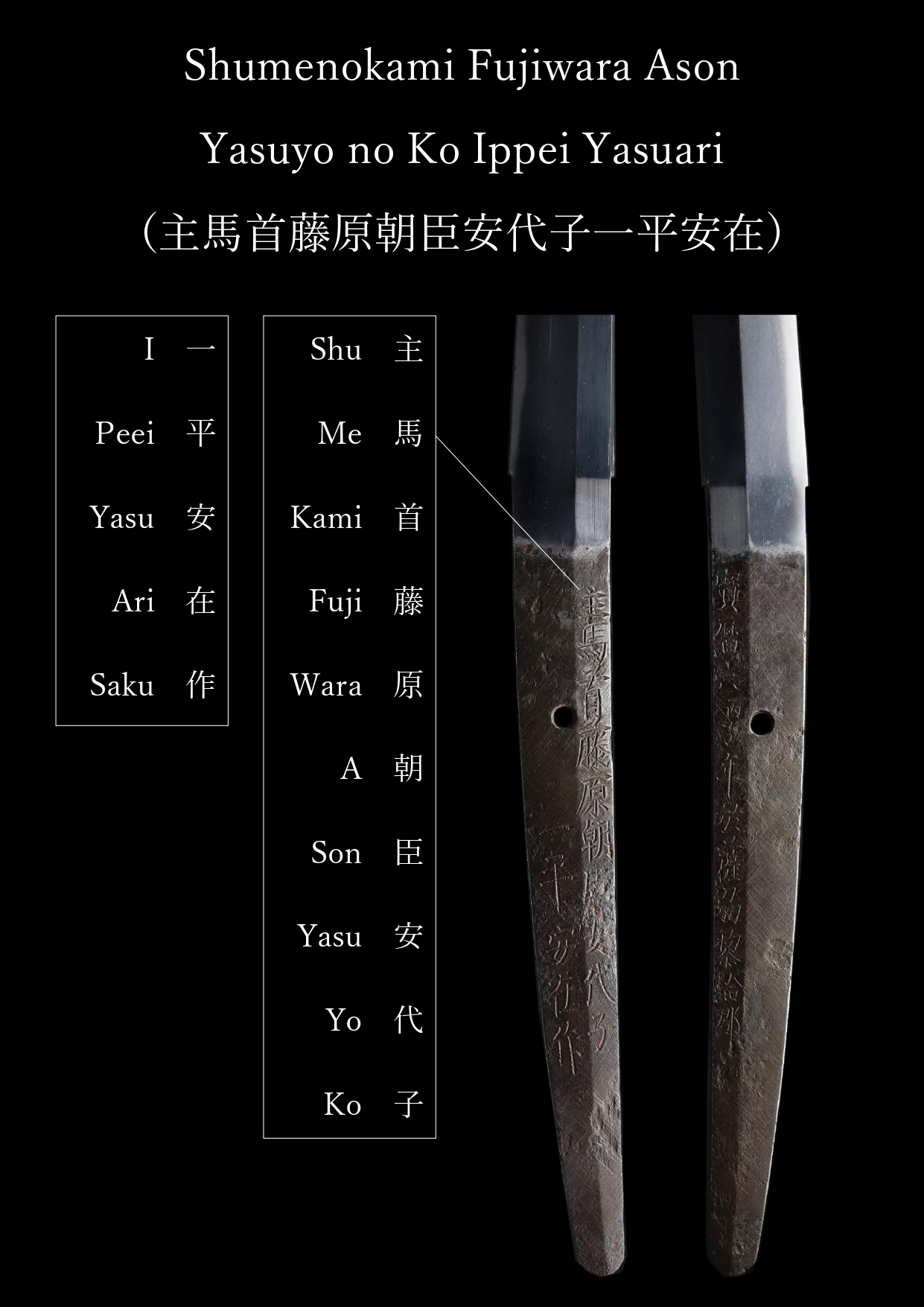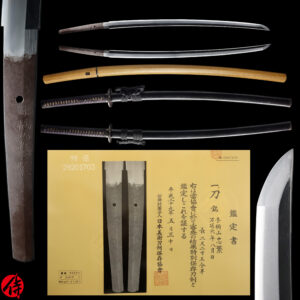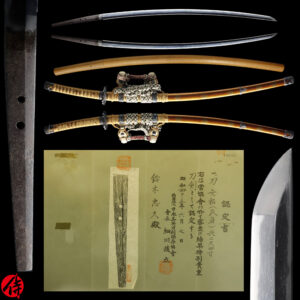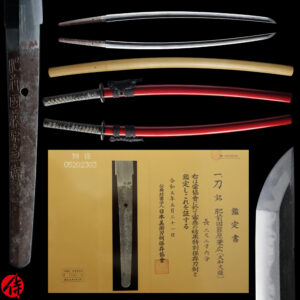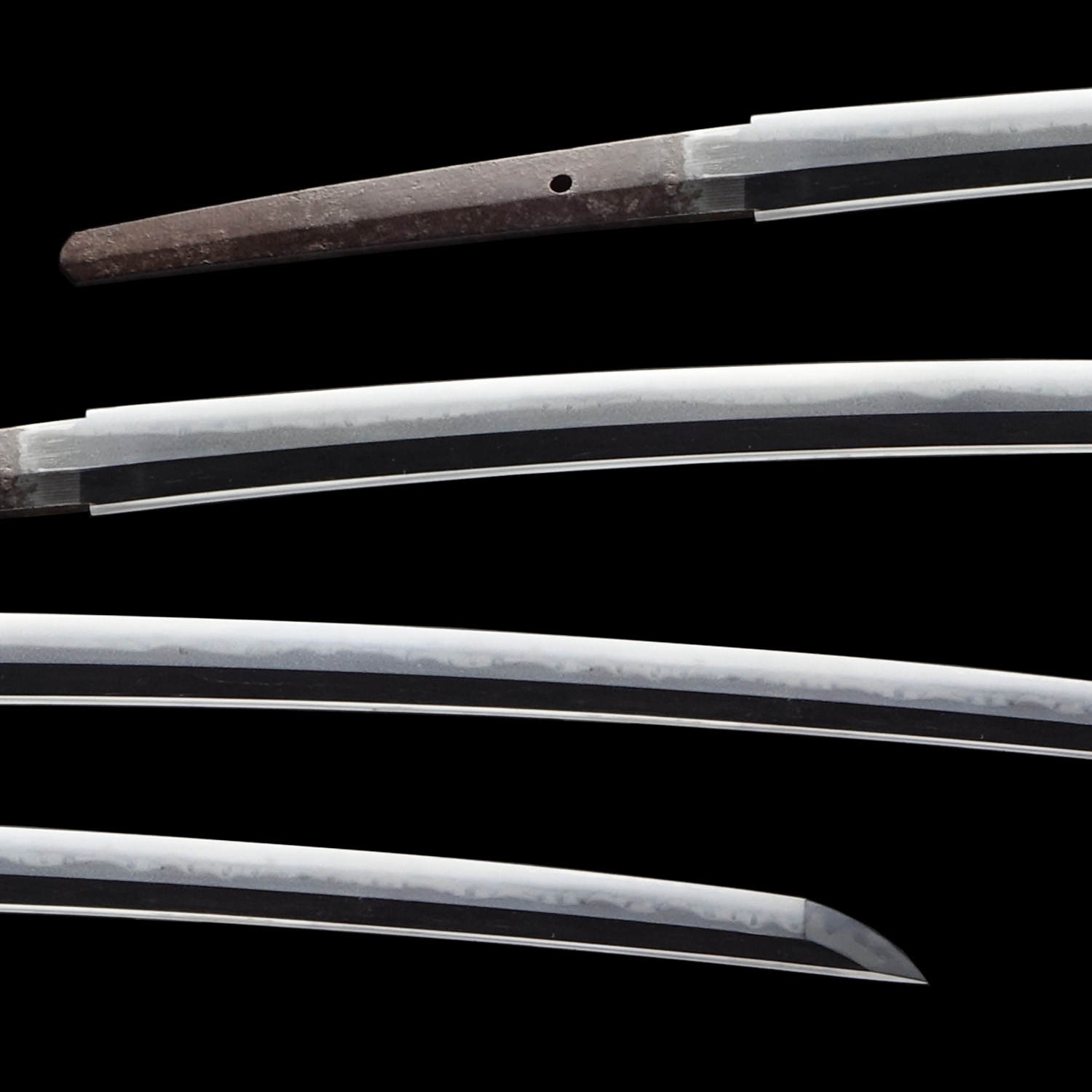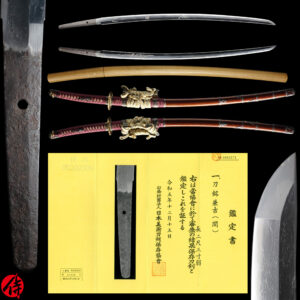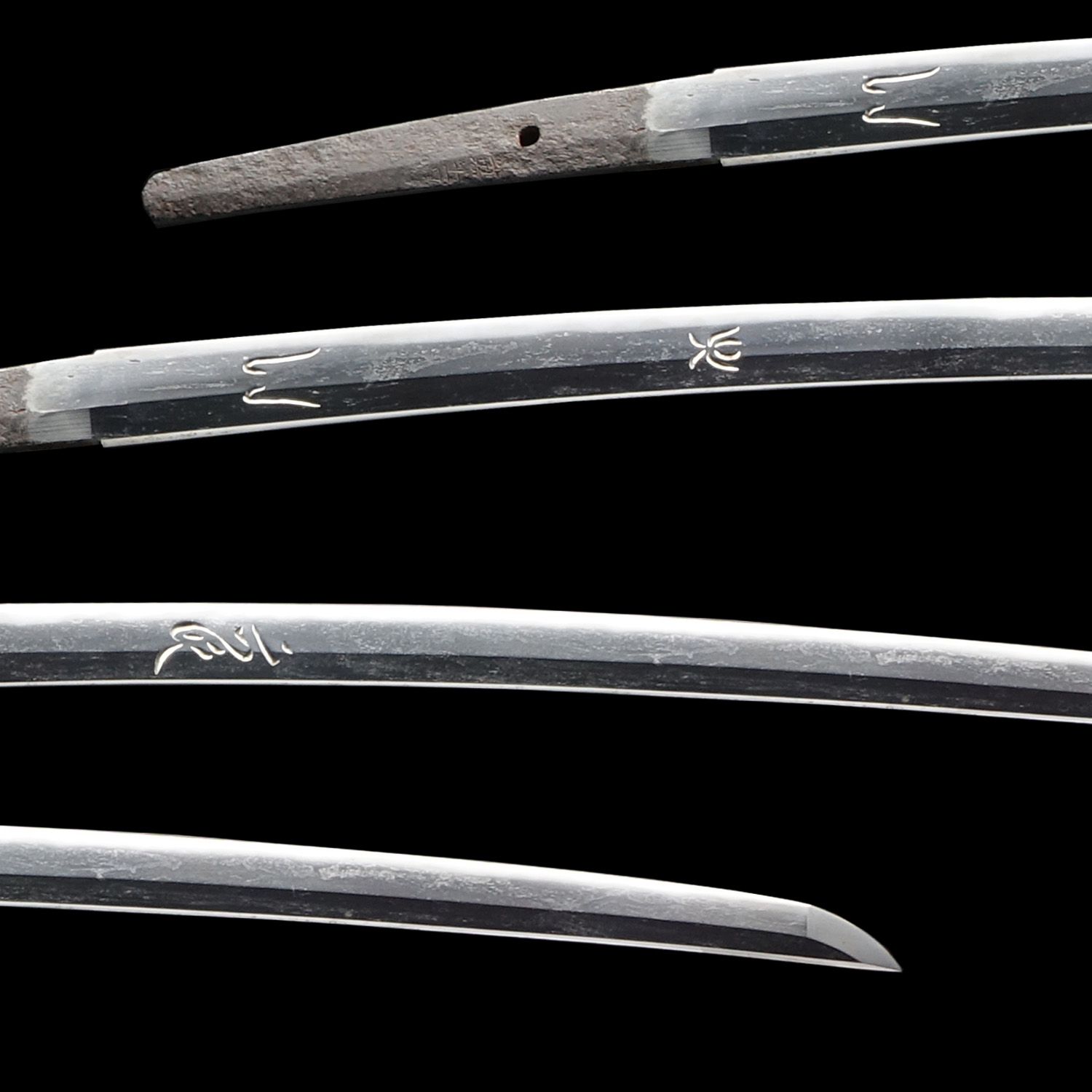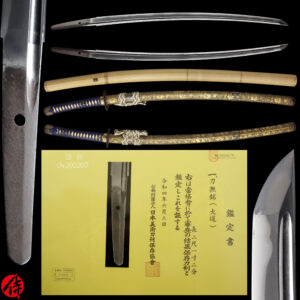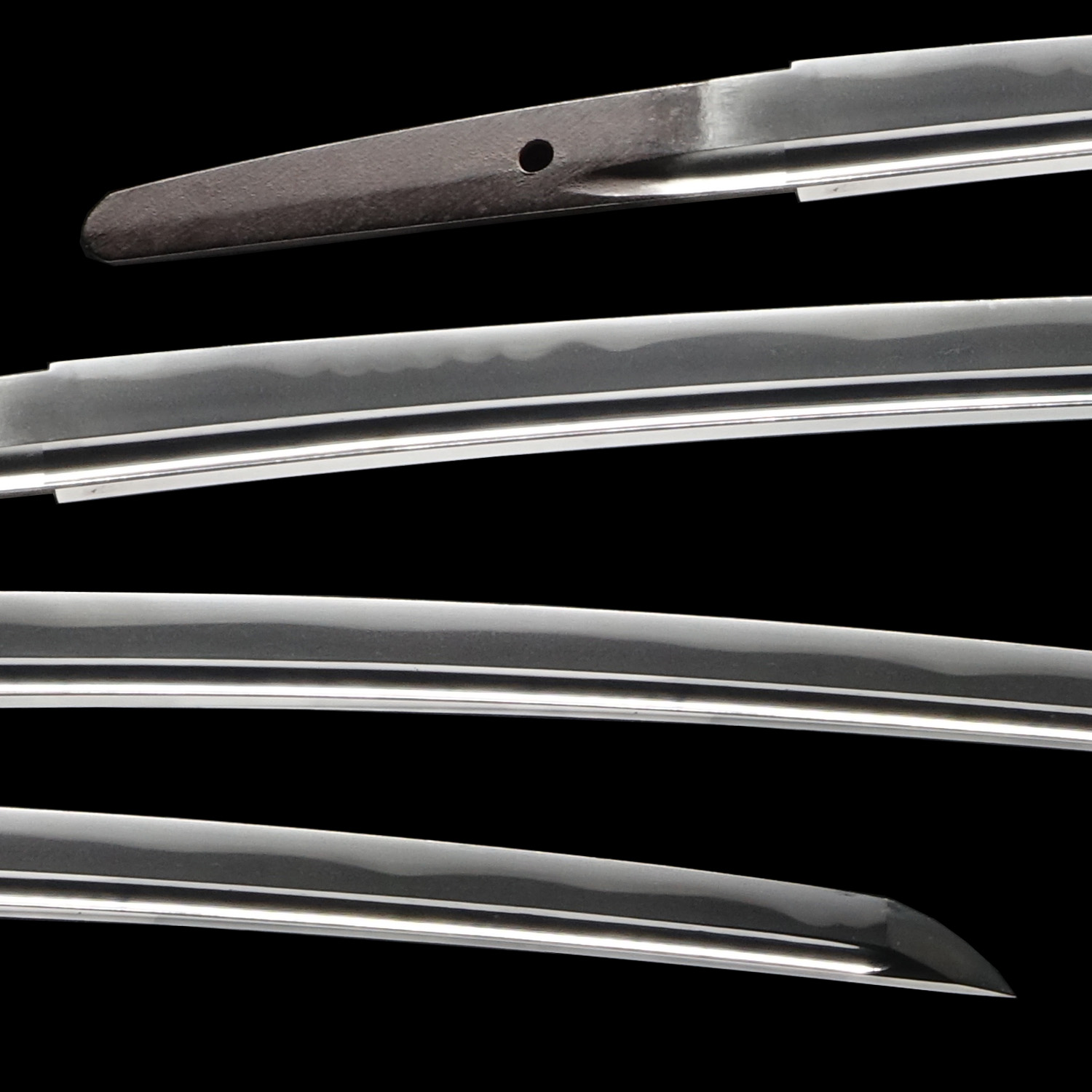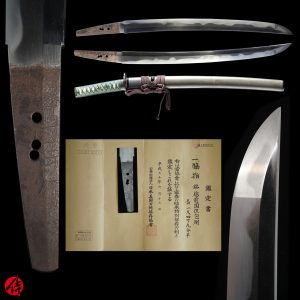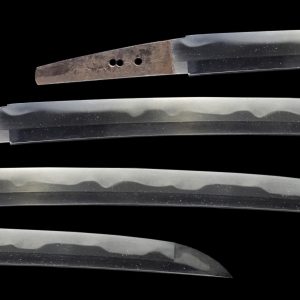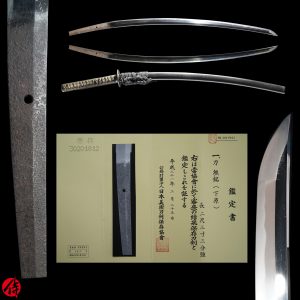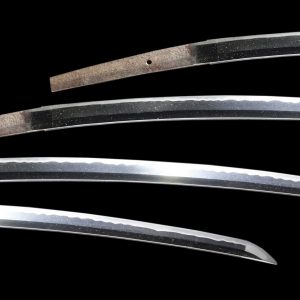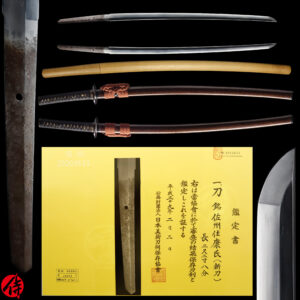Antique Japanese Sword Katana Signed by Yasuari with Tokubetsu Hozon Certificate
【Description】
Summary
This blade was signed by Shume no Kami Ason Yasuyo Ko Ippei Yasuari (主馬首朝臣安代子一平安在) in the 6th year of the Horeki era (1756: Mid Edo Period) in Satsuma domain (Today’s Kagoshima prefecture). Yasunari was active during 1751-1764.
The maker’s name is Ippei Yasuari (一平安在), and the first part of the Kanji characters means that he was the son of Shume no Kami Ason Yasuyo. Yasuari was initially born as the son of Kiyofusa (清房) but was adopted by Yasuyo.
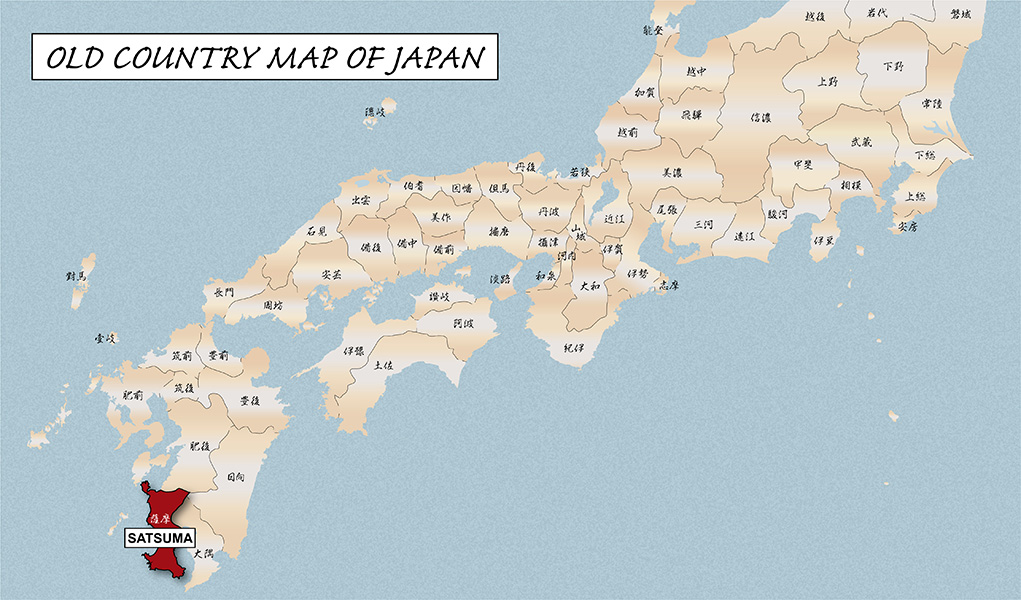
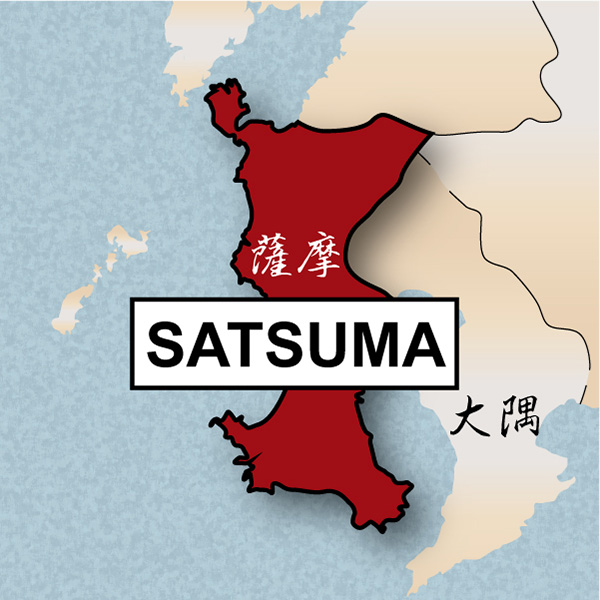
Ippei Yasuyo (His father)
Ippei Yasuyo was one of the most famous swordsmiths in Satsuma domain in the mid-Edo period. He was born as the son of Ippei Yasusada in the 8th year of the Enpo era (1680). He first learned sword-forging techniques from his father and then became Naminohira Yasukuni’s apprentice. Yasuyo was especially active during the Genroku era (1688-1704). The 8th-gen Tokugawa Shogun, Tokugawa Yoshimune, encouraged swordsmiths nationwide to improve their craftsmanship as his policy, and Yoshimune made a list of the most renowned swordsmiths. And, Yasuyo was selected as one of the representatives from Satsuma domain.
Shogun Yoshimune often invited listed swordsmiths to Edo City so that they could forge blades in front of the Shogun. Yasuyo showed his high level of craftsmanship to the Shogun in 1721. As an acknowledgment from the Shogun, Yasuyo received the honorable official title of Shume no Kami (主馬首). He was also allowed to inscribe the holly oak emblem, the family crest of Tokugawa Shogunate. These facts indicate that Yasuyo was one of the most reputable swordsmiths. Yasuari, his son, must have learned this amazing craftsmanship from Yasuyo. And Yasunari often inscribed his father’s name before his signature. We presume Yasuari wanted to show respect to his father. Knowing that Yasuyo adopted Yasuari, Yasuari was the successor of Yasuyo. This means that Yasuari also mastered superb sword-forging techniques.
Naminohira School
Yasuyo, his father, learned sword-forging techniques from Namihira Yasukuni, who belonged to Naminohira school. We would like to touch on the history of this school.
Naminohira(波平) was one of the most influential schools in Satsuma domain founded by a Yamato-Den swordsmith Masakuni(正國), during the late-Heian period(Late 12th century). They were known for having their smith name with one of these letters, 行(Yuki) or 安(Yasu).
The Naminohira swords were cherished among Samurais in the marine army, mainly because the name Naminohira(波平) means “Tides are quiet.” in Japanese.
The origin of the name Naminohira dates back to the school’s foundation. It is said that the founder Masakuni was able to calm the waves by dedicating his sword to the sea when his school from Yamato sailed to live in Satsuma domain. Since then, he began to use the title “Naminohira Yukiyasu (波平行安)” – “Tides are quiet, ’tis an easy way.” From the late-Heian period until the end of Samurai times(Late 19th century), the Naminohira family kept the mastership for a thousand years.
Satsuma Domain
Satsuma province had a high ratio of Samurai population compared to other parts of Japan. And they are famous for their military power, ruled by Shimazu clan. We assume a swordsmith needed to be skilled to stay active and popular in this demanding place. Yasuyo and Yasuari are good examples.
It is appraised as a Tokubetsu Hozon Token(特別保存刀剣) issued by NBTHK(Nihon Bijutsu Touken Hozon Kyokai:日本美術刀剣保存協会). This authentication paper was only given to authentic Japanese swords, especially well preserved and high quality with artistic value.
*Please keep in mind that there is a relatively noticeable Kitae Kizu on the Shinogi and Mune part. If you like to see more details, please feel free to contact us.
【 Blade】
Cutting Edge Length(Nagasa):75.5 cm ( 29.7 inches)
Curvature(Sori): 1.8 cm (0.71 inches)

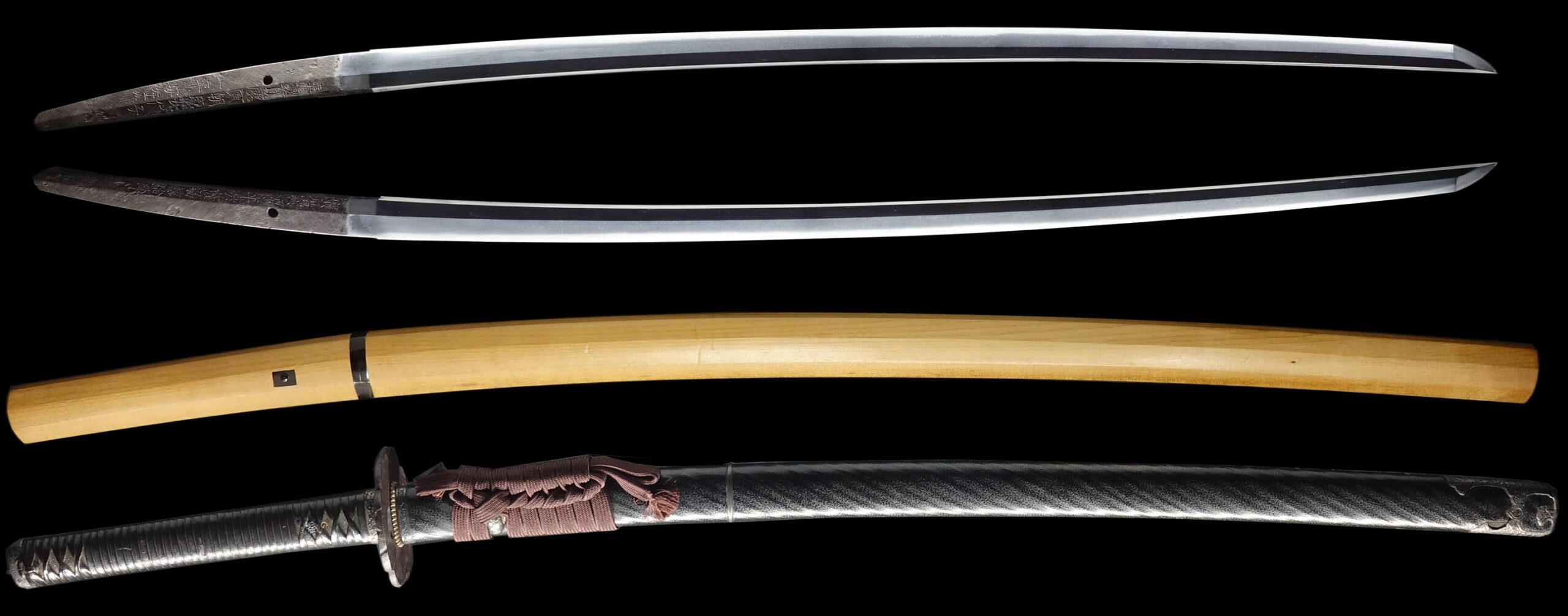
Hamon:
The crystalline structure which forms along the cutting edge of a blade as a result of the hardening process
Jimon(Jihada):
visible steel surface pattern created by folding and hammering during forging process

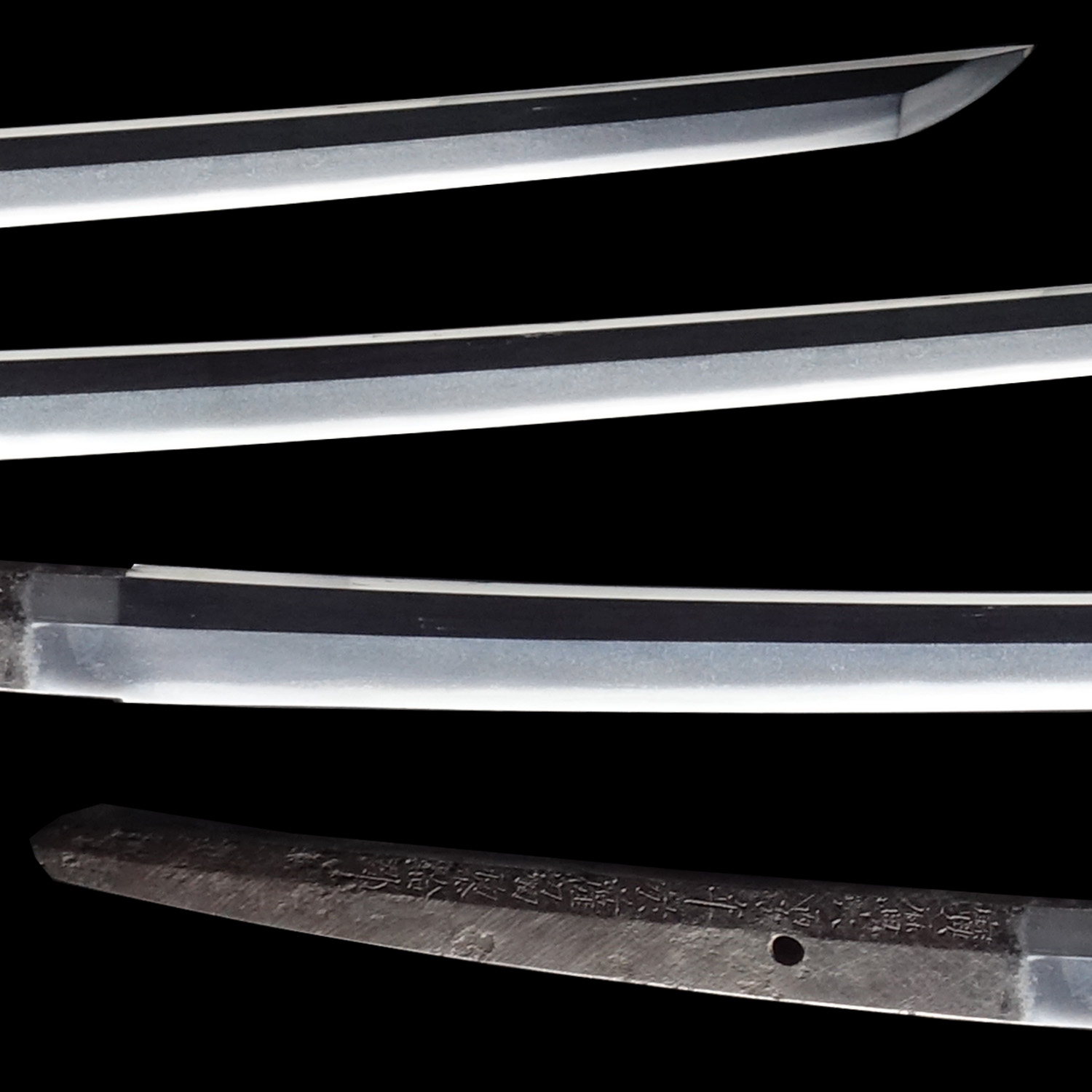
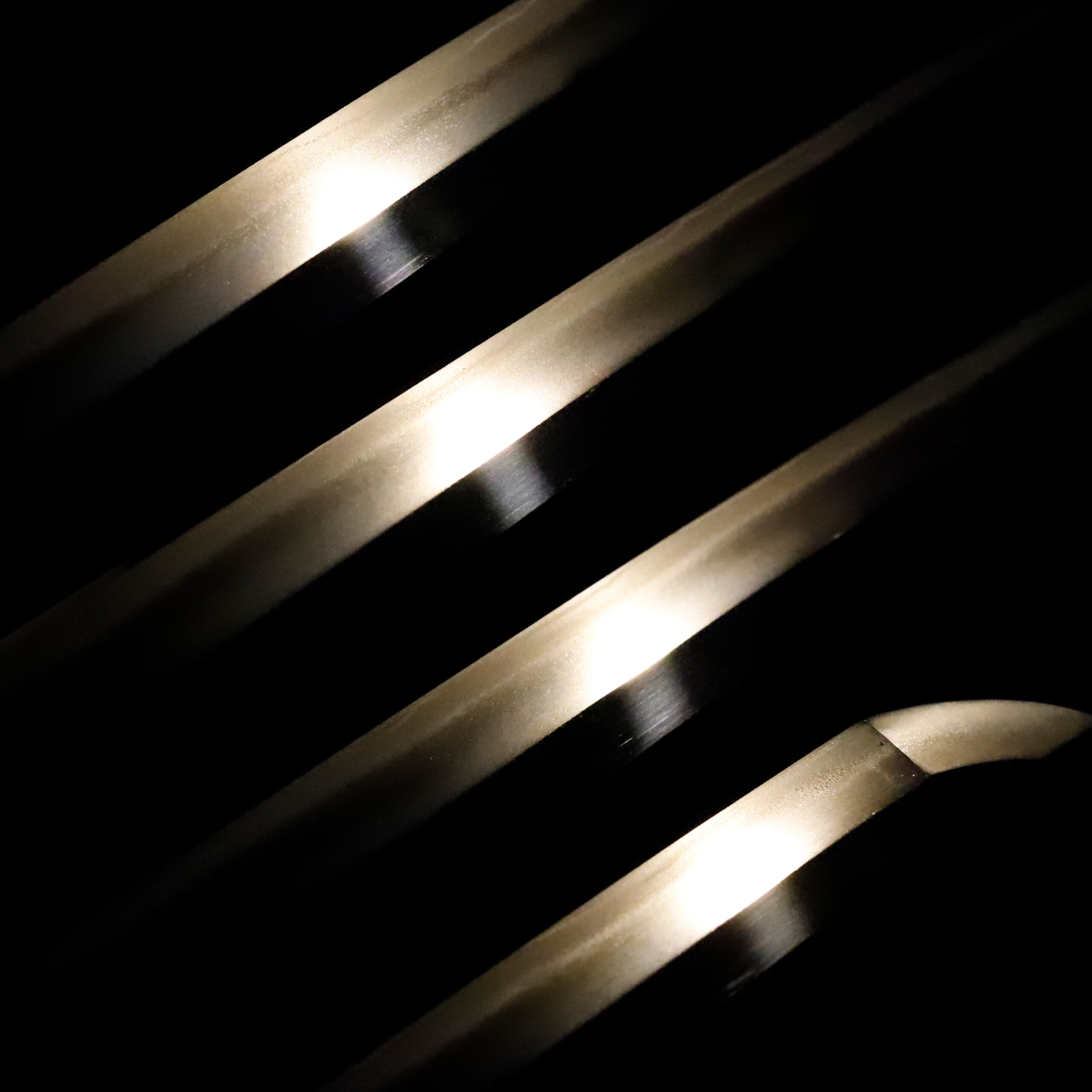

Nakago:Nakago is the tang of the Japanese sword.
Japanese swordsmiths left the black rust on the tang because it prevents red rust while the tang is in its handle. And the discoloration of the tang was created over time, and it is a great indicator for a Japanese sword specialist to estimate when the sword was forged.
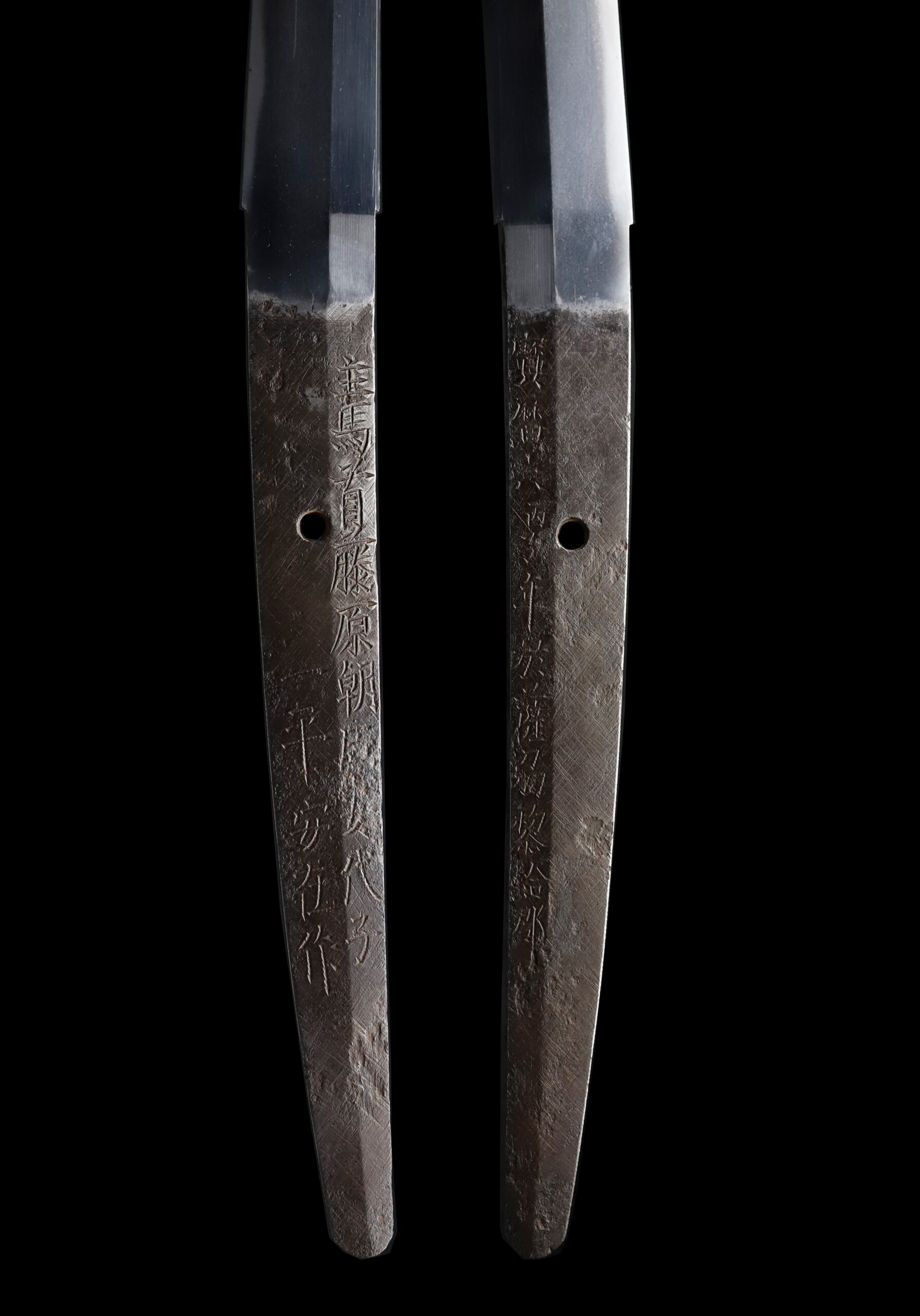
Koshirae: Koshirae is the mounting of the Japanese sword. There are several parts that consist of Koshirae such as Saya(Scabbard), Tsuka(Handle), Tsuba(Handguard).

Fuchi-Kashira:A pair of matching sword fittings that cover the upper and bottom parts of its sword hilt.
It seems several plant patterns are engraved on this Fuchi Kashira. We estimate golden paint was initially applied to it. The surface has worn considerably over time, making it difficult to distinguish even the details of the design. I want you to enjoy it as an antique texture because it is a substitute that has passed through so many years.
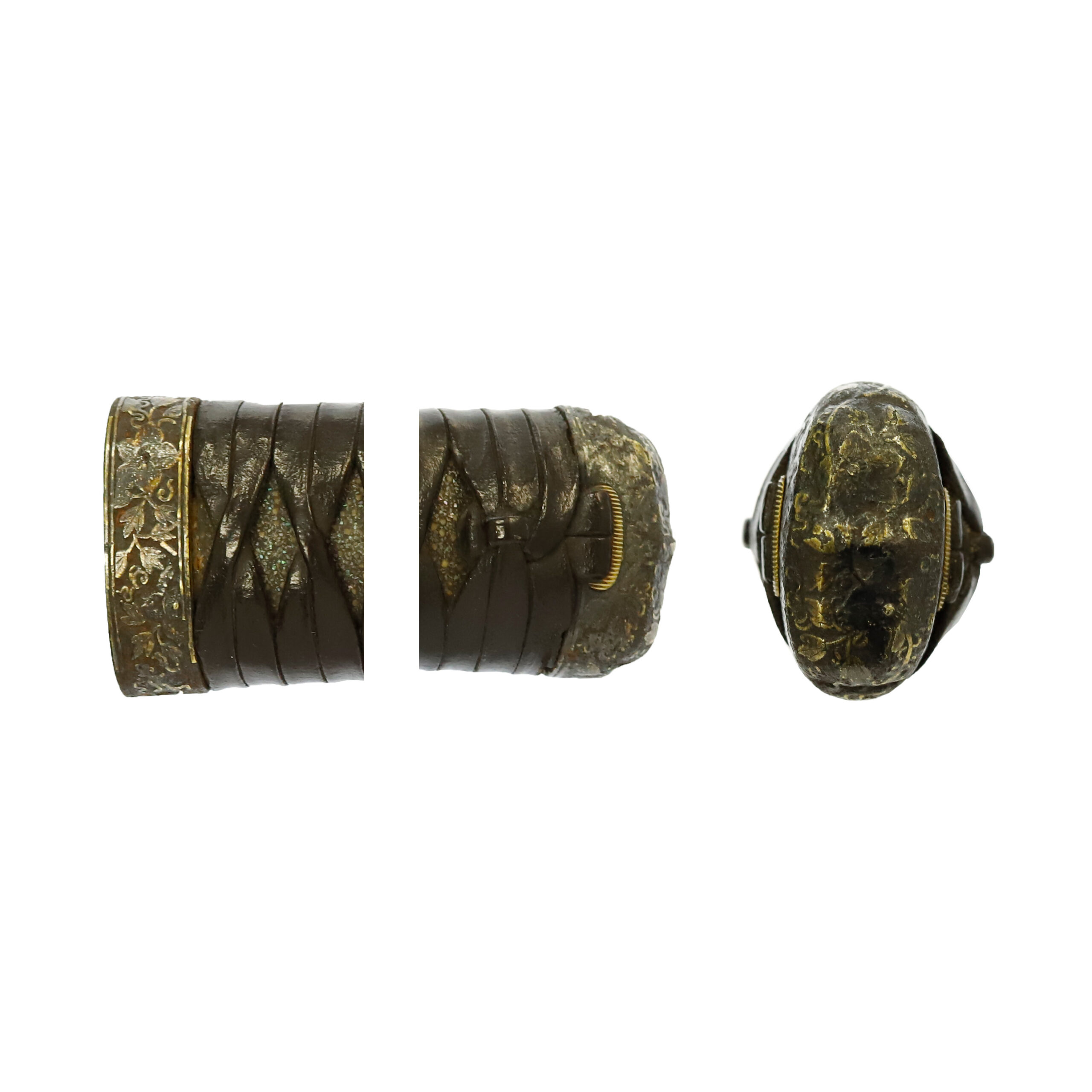
Tsuka and Menuki:Tsuka is the handle of the Japanese sword and Menuki is its decoration.
This handle is wrapped with leather, and Menuki is not attached. This handle’s Tsukamaki (柄巻, generic term for string wrapped around the entire handle), its type of Tsukamaki is called the Ikkanmaki (一貫巻). In this Tsukamaki method, rhombus patterns appear only on both ends of the handle, and the center of the handle is flat.
The Tsukamaki itself is initially intended to reinforce the handle and make it easier to fix the hand’s position when grasping the handle, so various threads and winding methods were used depending on how practical and decorative it is. This Koshirae’s handle is one of the methods born from such trial and error.
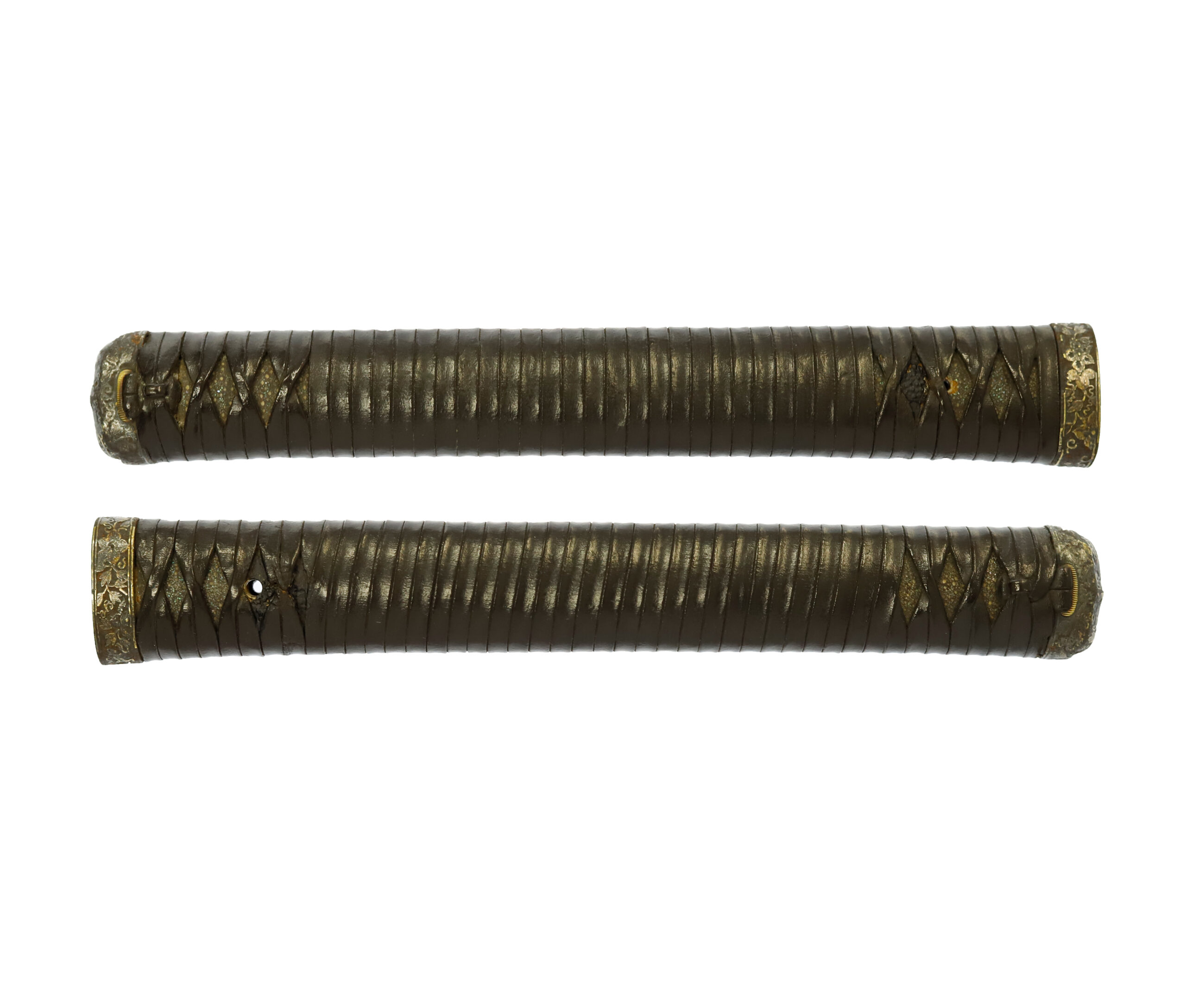
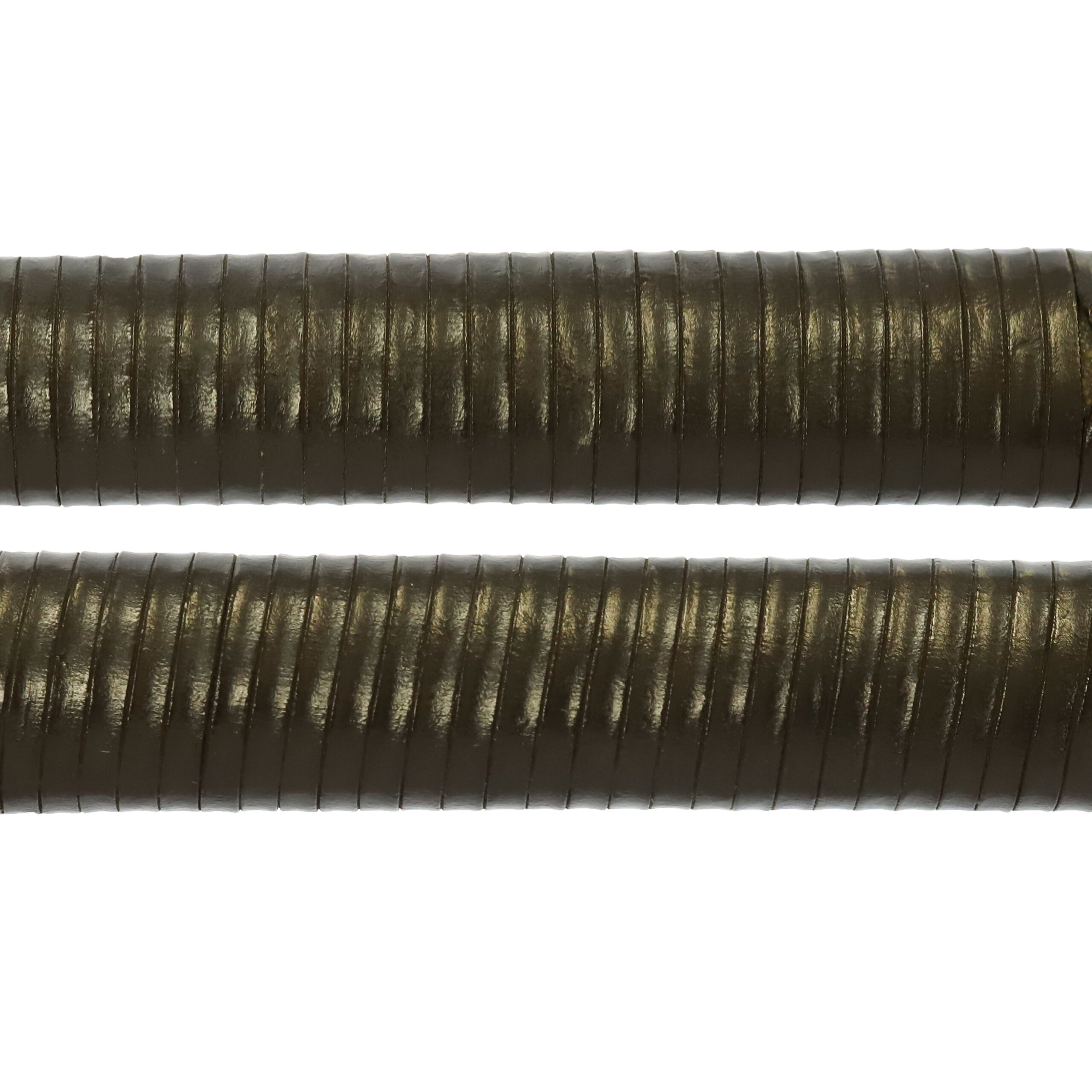
Tsuba and Habaki:Tsuba is the handguard for the Japanese Sword and Habaki is the equipment to make the blade not touch its scabbard inside. It prevents the blade from getting rusty and chipped.
Yotsu-Mokkou-shaped iron Tsuba that has Kozuka and Kougai holes. Its origin is the shape of eggs in a nest. When a quince (it is written 木瓜 in Japanese) is cut into round slices, its cross-section looks similar to this shape; therefore, it was named Mokkougata Tsuba (木瓜形鐔). Yotsu-Mokkougata (四ツ木瓜形, a combination of four Mokkou shapes) Tsuba is often seen, same as this Tsuba.
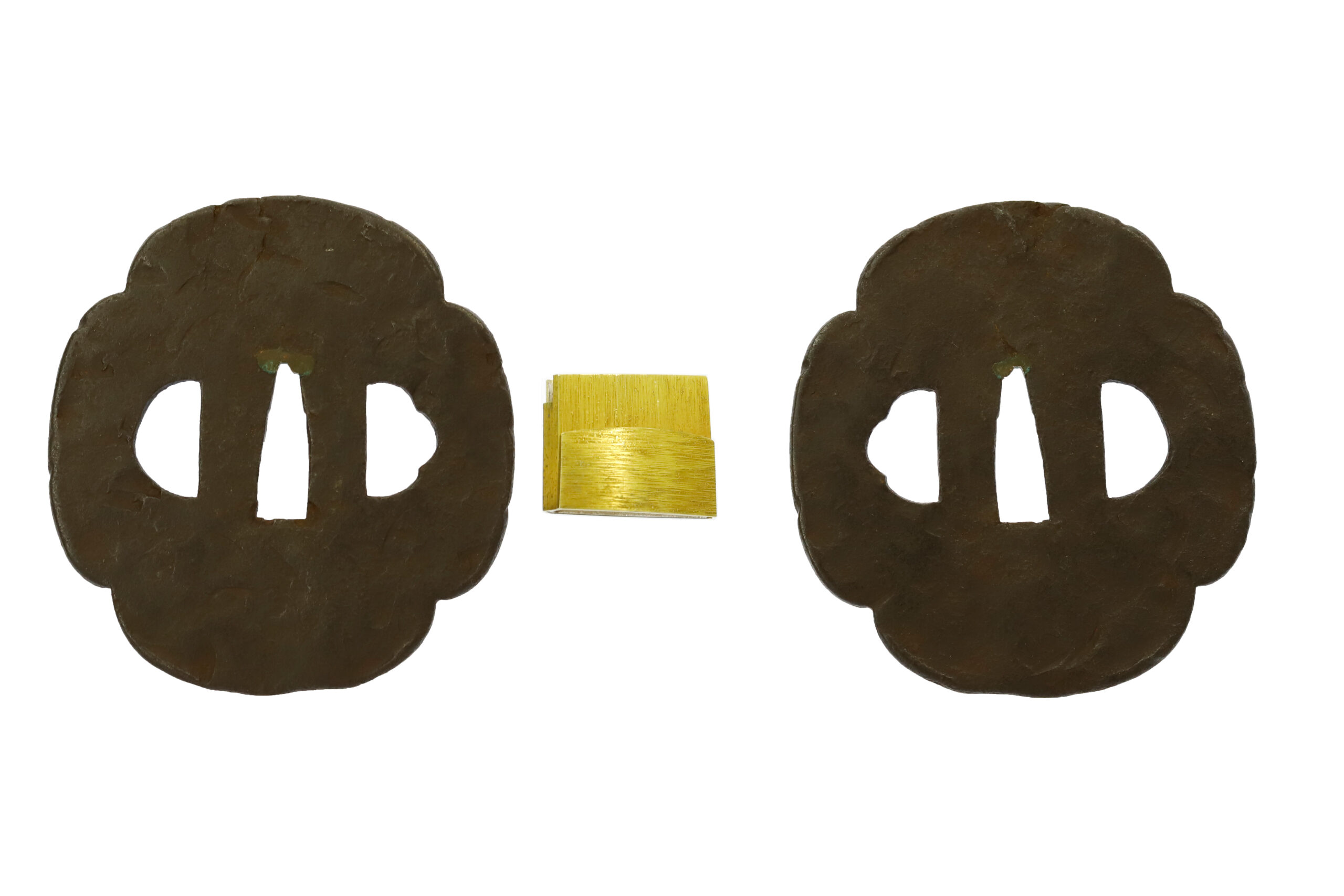
Saya: Saya is the scabbard for the Japanese sword.
*Please keep in mind that there are areas where lacquer came off. We will have these parts repaired upon your request after the purchase.
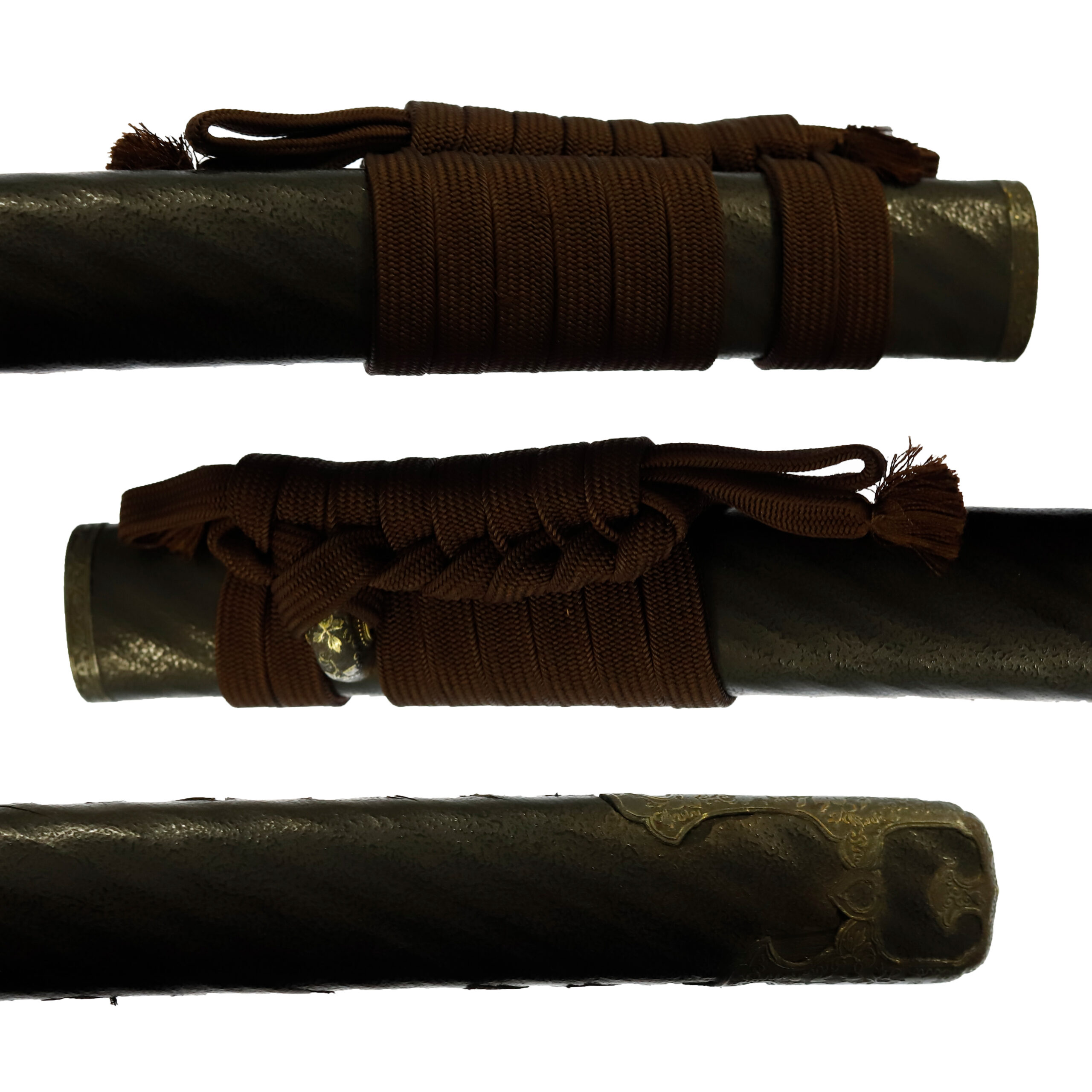
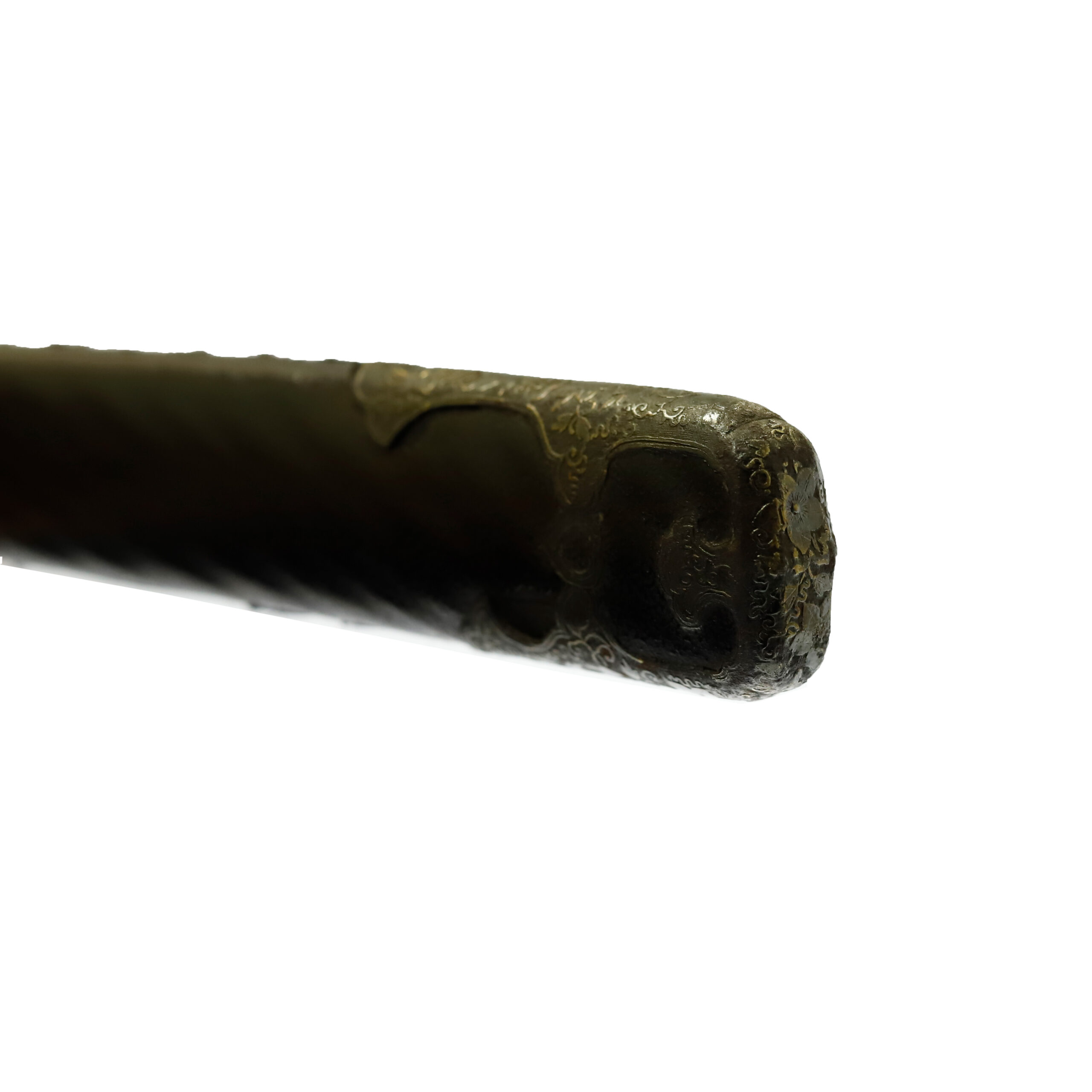
Authentication Paper:NBTHK TOKUBETSU Hozon Certificate for the blade (No. 1018337)
NBTHK, also known as Nihon Bijutsu Touken Hozon Kyokai (the Society for the Preservation of the Japan Art Sword), is one of the oldest Japanese sword appraising organizations in modern-day Japan. They authenticated the blade on August 25th in the 4th year of Reiwa (2022). They appraised it as Tokubetsu Hozon Touken, the blade especially worth preserving for Japanese society. The purchaser will receive this original certificate as well. We can also translate what is written into English and make a PDF file for your record if you request.
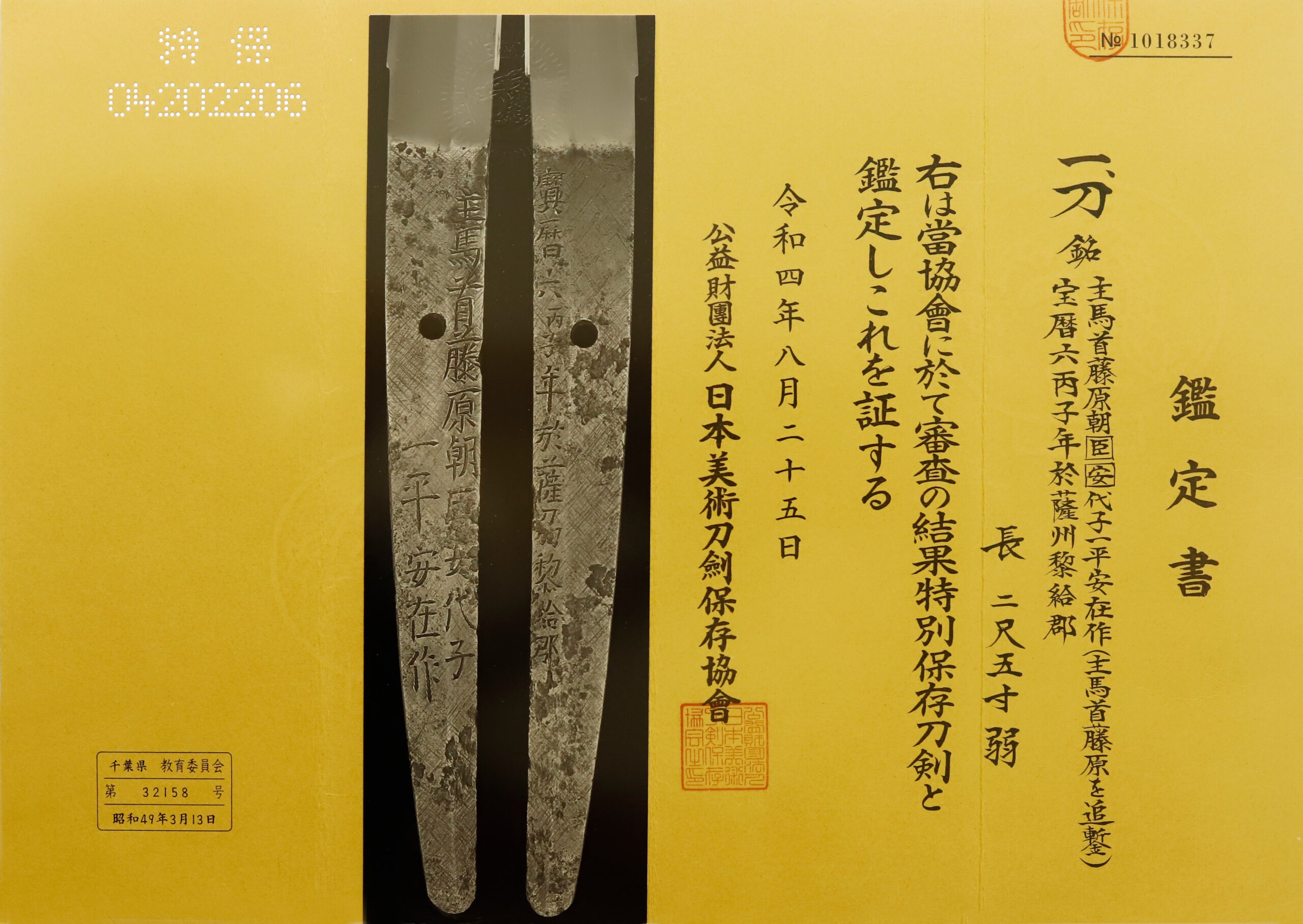
Registration Number : Chiba 32158
The Board of Education in Chiba prefecture issued a registration paper for this sword . It is called Jyu Token Rui Torokusho(銃刀剣類登録証). Bunkacho(The Agency for Cultural Affairs) acknowledges a Japanese sword with this paper as a work of art.
The sword needs to be traditionally hand-forged and made of Tamahagane carbon steel to be registered in the system. With this paper, its owner in Japan can legally own an authentic Japanese sword. Based on this registration number, we will apply for its export permit.
This paper will need to be returned to the board of education when the sword is being shipped abroad, but you can receive a copy of it. An English translation of this registration paper is available on request.

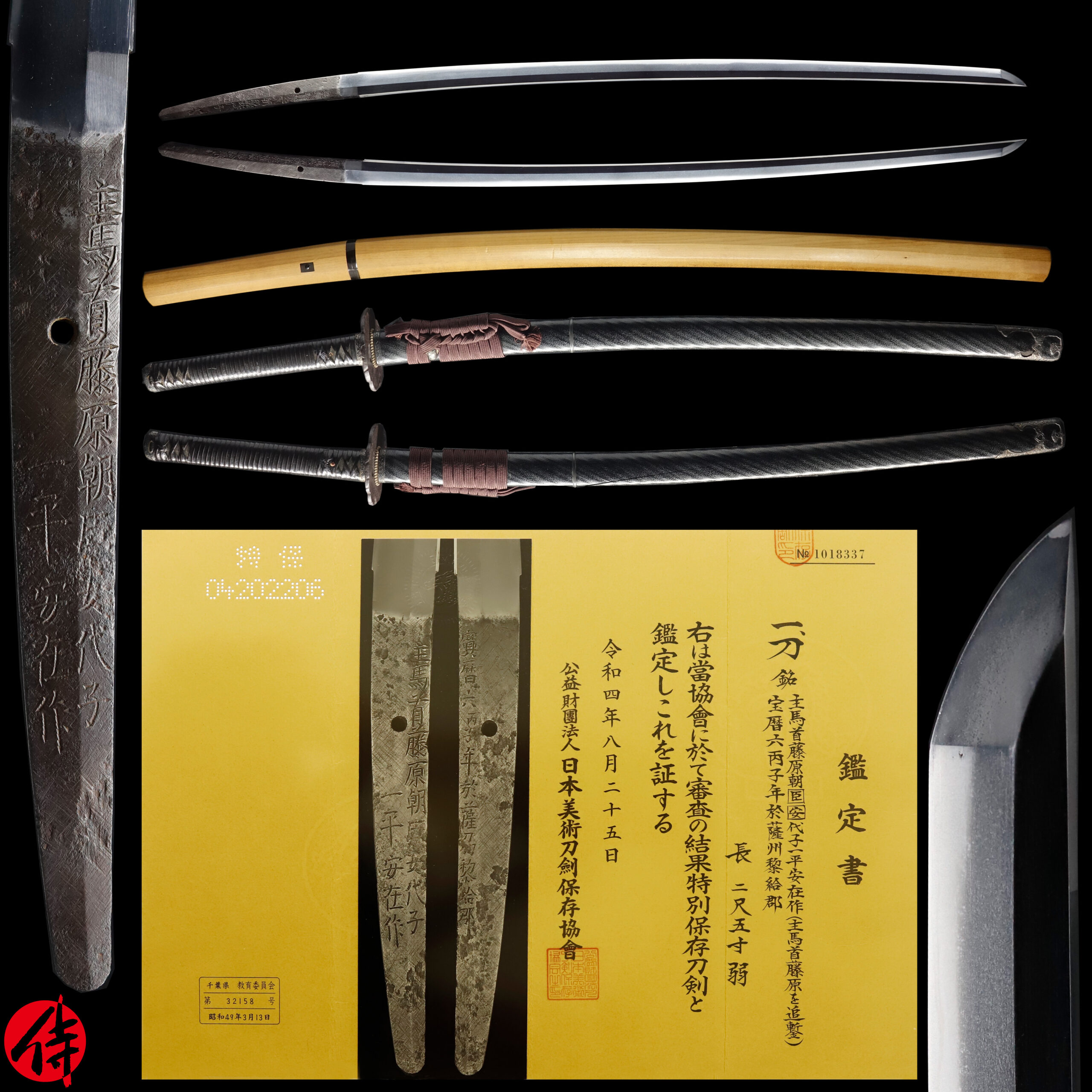
—————————————————————–
【About us】
Samurai Museum is located in Tokyo, Japan, exhibiting antique artifacts related to the Samurai history. Samurai Museum Shop is the place for those who are interested in Japanese culture and craftsmanship. We deal with antique Samurai swords/armor, traditional crafts made in Japan and so on.
【Japanese Sword& Export Process】
The Japanese swords we deal with are hand-forged edged swords made in Japan. It was made from the traditional carbon steel called TAMAHAGANE(玉鋼). Samurai Museum is familiar with the proper legal procedure for an antique/ authentic Japanese sword to be exported from Japan. We have sent more than 700 Japanese swords for the past few years (~2024) to amazing owners who appreciate its historical value.
Each Japanese sword is registered under the Agency for Cultural Affairs and the Board of Education in Japan. They issue a registration paper for each Japanese sword for its owner in Japan to legally possess it. The Japanese sword with its registration paper means it was traditionally hand-forged in Japan.
To legally export the sword from Japan to other countries, we will have to apply for its permit to the Agency for Cultural Affairs(Bunkacho) and return the original registration paper to the Board of Education. It normally takes around 2-4 weeks to receive this permit after submitting required documents. And we would like you to expect at least 1-1.5 months for your order to arrive at your given address after you ordered. For more detailed info, please click here.
It is allowed for residents in Japan to own authentic Japanese swords without a special license as long as they come with registration papers. Please feel free to contact us if you are a resident of Japan, whether temporarily or permanently. We will also assist you when you leave Japan and need to obtain the export permit.
【Payment Method】
We accept payment through Stripe (Credit card), PayPal, Apple Pay or ChromePay, all of which are secure payment methods. Also, you don’t need to make an account on Stripe for the checkout. If you prefer other payment method, please contact us. After confirming your payment, we will apply for an export permit. You may either pay in JPY, USD, AUD, CAD,EUR CHF or GBP. The price is set in Japanese Yen. Prices in other currencies are automatically calculated based on the latest exchange rate.

* If the amount is above 1 million JPY, Stripe or wire transfer will be the only options for payment.
【Shipping】
We have shipped authentic Japanese swords to the USA, Canada, Mexico, Germany , Belgium, France, Finland, Hong Kong, Australia. If you don’t live in these countries and like to order, please contact us first before making a purchase. We offer Free International Shipping as long as we can send antique Japanese swords by EMS.
We normally ship by EMS(Express Mail Service) provided by Japan Post. We will send you a tracking number for your order as soon as we hand it to the post office. We will put 100 % insurance on the shipping document without any extra charge. Based on the total amount, there might be a duty tax or other fee for you to pay, depending on the countries. We use package cushioning to protect the item and put it in a PVC pipe, which is one of the most secure packages because of its durability.
It will normally takes 5-14 days for the item to arrive at your given address after we dispatch it. Time of delivery is estimated as accurately as possible by the carrier but does not take into account any delays beyond our control such as by inclement weather, post office holiday seasons.
* If you live in Australia and like to purchase an authentic Japanese sword, please click here to know the detail.
* If you live in the UK and like to purchase an authentic Japanese sword, please contact us first and click here to know the detail.

【Review】
Here is one of the reviews we received from a customer who purchased an authentic Japanese sword from us. For more reviews, please click here.
“My experience overall with the whole process was wonderful. I had many questions about the history and process to purchase these treasures. All my questions were answered very timely and complete. The staff is very knowledgeable and very well versed if any questions do arise.”
【How to make sure the condition】
Please keep in mind that what you are going to purchase is an antique item. We uploaded high resolution photos for you to check its condition thoroughly. If you like to see more photos with different angles, please feel free to contact us. We will be happy to send them to you so that you can make informed decision. It is essential for us to know that you are happy with your choice of a sword. and we are prepared to use the best of our ability to serve you.
【How To Contact Us】
Please contact us through email, Facebook Messenger or Live Chat if you have any questions. You can find each icon on the right side of the website. Please click one of them to reach us. We will reply to you within 1-2 business days.
【The Art of Nihonto (Japanese Sword)】
Samurai’s history is a profound, eloquent legacy of ancient Japanese warriors in which millions of people worldwide are being fascinated. If you like to find out the art of Nihonto, please click here.
【A Guide to Japanese Sword Maintenance】
After acquiring an genuine Japanese sword, it is also important to know how to take good care of it. Here is the special video for you. Mr. Paul Martin, Japanese sword expert, shows you how to give proper maintenance to your sword. By mastering how to clean the Japanese sword, its aesthetic beauty will last forever.
When you purchase a Japanese sword from us, you can get a Free Japanese sword maintenance kit. It comes with four tools(Choji Oil, Uchiko Whetstone Powder, Peg remover, Oil Applicator). By watching the video instruction above , you can enjoy learning how to maintain your Japanese sword while appreciating it. If you have any difficulty assembling the sword or cleaning the blade, you can feel free to contact us.


MORE ANTIQUE JAPANESE SWORD FOR SALE
SWORDS WITHOUT CERTIFICATES FOR SALE
LEARN JAPANESE SWORD TERMINOLOGY
Thank you for reading all the information on the page. If you have any difficulty choosing the right Japanese sword for you, we will be more than happy to help you find the one that speaks to you the most. Please feel free to contact us.

